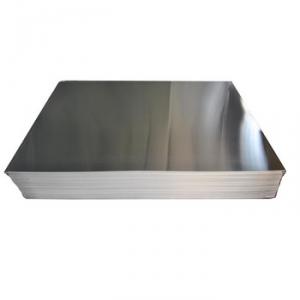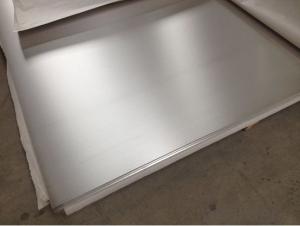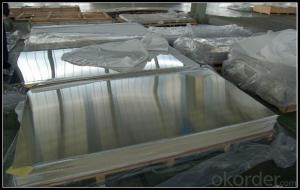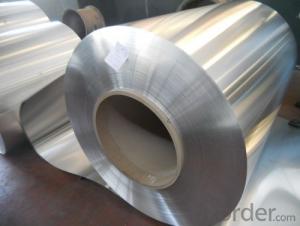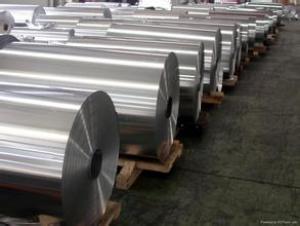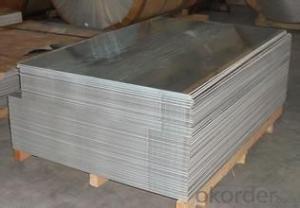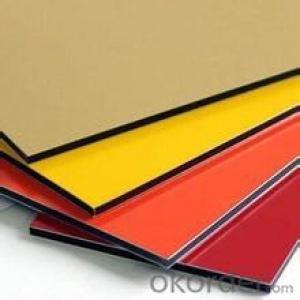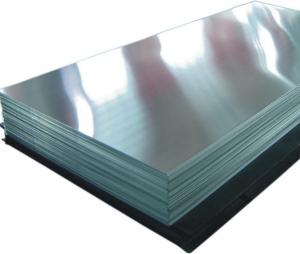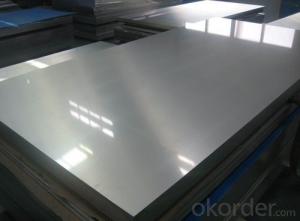Sheets of 063 Aluminum 25lbs 4 8 Sheet - LMetro Mount Pad for Draft Simll,7005-T6 for Train
- Loading Port:
- Shanghai
- Payment Terms:
- TT or LC
- Min Order Qty:
- 1 m.t.
- Supply Capability:
- 1000 m.t./month
OKorder Service Pledge
OKorder Financial Service
You Might Also Like
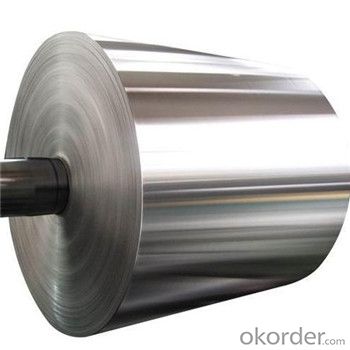 7XXX series aluminum alloy is mainly added zinc and also a small amount of magnesium and copper. Some of the super-hard alloys among this series are nearly as hard as steel due to the addition of zinc, lead, magnesium and copper to the composition. It can be strengthened by heat treatment. Main applications: aviation sector (strength-bearing parts and undercarriage for airplanes), rockets, propellers, space-crafts
7XXX series aluminum alloy is mainly added zinc and also a small amount of magnesium and copper. Some of the super-hard alloys among this series are nearly as hard as steel due to the addition of zinc, lead, magnesium and copper to the composition. It can be strengthened by heat treatment. Main applications: aviation sector (strength-bearing parts and undercarriage for airplanes), rockets, propellers, space-crafts
(1).Grade Alloy: 1050,1060,1070,1100,3003.
(2).Producing Standard: ASTM,EN,DIN,JP,CN.
(3).Temple Level: O(soft) ,H14,H24,etc.
(4).Thickness:0.3mm-3.0mm
(5).Diameter:50-1250mm
Coal is extracted from the ground by coal mining, either underground by shaft mining, or at ground level by open pit mining extraction. Since 1983 the world top coal producer has been China.In 2011 China produced 3,520 million tonnes of coal – 49.5% of 7,695 million tonnes world coal production. In 2011 other large producers were United States (993 million tonnes), India (589), European Union (576) and Australia (416).[9] In 2010 the largest exporters were Australia with 328 million tonnes (27.1% of world coal export) and Indonesia with 316 million tonnes (26.1%),while the largest importers were Japan with 207 million tonnes (17.5% of world coal import), China with 195 million tonnes (16.6%) and South Korea with 126 million tonnes (10.7%).
- Q: write a balanced equation for the reaction between aluminium metal and potassium hydroxide in water
- Hi there! So you're given Aluminum metal, which has the oxidation state (almost always) of 3+. In play are: Al 3+ K+ OH- You have KOH(aq) + Al 3+ and they react to form a precipitate, creating Al(OH)3 and the potassium cation disperses into solution. In traditional symbols: 3 KOH (aq) + Al 3+(s) ----- Al(OH)3(s) + 3K+ (aq) That's 3 K+, 3 OH-, and 1 Al 3+. That carries for both sides! NIE would look like: 3 OH- + Al 3+ ----- Al(OH)3 (s) Most instructors don't mind if you leave off (aq) but pretty much all of them care about (s), so make sure you add those phase states! I hope I helped :)
- Q: Can aluminum plate resist acid and alkali?
- The metal oxide film changes the surface state and properties, such as surface coloring, corrosion resistance, abrasion resistance and hardness, and metal surface protection. For example, aluminum anodizing, the aluminum alloy placed in the corresponding electrolyte (such as sulfuric acid, chromic acid, oxalic acid, etc.) as an anode, under certain conditions and applied electricity under the electrolysis. Anodized aluminum or its alloy, formed on the surface of alumina thin layer, its thickness is 5~20 microns, anodized aluminum or its alloy. Therefore, the surface hardness and wear resistance of the aluminum alloy were greatly improved by the treatment process.Shanghai Ai Li AI metal materials, dedicated to serve you.
- Q: How do aluminum sheets perform in terms of thermal insulation?
- Aluminum sheets have poor thermal insulation properties. They conduct heat very well, which means they are not effective in preventing heat transfer between different areas or maintaining a consistent temperature.
- Q: Can aluminum sheets be bent without cracking?
- Yes, aluminum sheets can be bent without cracking, as long as the bending process is done carefully and within the material's limits.
- Q: Can the aluminum sheets be used for manufacturing chemical piping systems?
- Yes, aluminum sheets can be used for manufacturing chemical piping systems. Aluminum is known for its excellent corrosion resistance, which makes it suitable for handling various chemicals. It is also lightweight, making installation and maintenance easier. Additionally, aluminum has good thermal conductivity, allowing for efficient heat transfer in chemical processes. However, it is important to consider the specific requirements of the chemicals being transported and consult with experts to ensure that the aluminum sheets chosen have the necessary properties and are compatible with the chemicals to be used in the piping system.
- Q: Can 101 aluminum sheets be painted or coated?
- Certainly! Aluminum sheets offer the possibility of being painted or coated. This adaptable material lends itself to receiving a range of finishes, including paint or protective coating, which can both elevate its visual appeal and safeguard it against corrosion. Whether it pertains to 101 aluminum sheets or any other aluminum variant, diverse techniques like spray painting, powder coating, or anodizing can be employed to paint or coat them. The selection of the appropriate paint or coating shall be contingent upon the desired aesthetics, performance criteria, and the precise utilization of the aluminum sheets.
- Q: I saw a nice looking set of cast aluminum pots for a very good price. They feel very heavy. But I remember hearing that aluminum is not healthy so I am wary of buying them. Any advice would be appreciated.
- Cast Aluminum Pots
- Q: What is the typical creep resistance of aluminum sheets?
- The typical creep resistance of aluminum sheets varies depending on the specific alloy and temper. Aluminum alloys typically have good creep resistance compared to other metals, especially at lower temperatures. However, the creep resistance of aluminum decreases significantly at higher temperatures. Aluminum sheets with higher alloying elements like copper, magnesium, or zinc tend to have better creep resistance than pure aluminum. Additionally, heat treatment processes such as cold rolling, annealing, or precipitation hardening can enhance the creep resistance of aluminum sheets. In general, aluminum sheets are known for their relatively low creep rates, making them suitable for various applications that require good dimensional stability over extended periods. However, it is important to note that the exact creep resistance of aluminum sheets can vary depending on the specific composition, processing, and operating conditions. Therefore, it is advisable to consult material specifications or conduct specific tests to determine the creep resistance of a particular aluminum sheet.
- Q: Can aluminum sheets be roll-formed?
- Yes, aluminum sheets can be roll-formed. Roll forming is a process in which a continuous strip of metal, in this case, aluminum, is fed through a series of rollers to gradually shape it into a desired profile or shape. Aluminum is an ideal material for roll forming due to its malleability and ductility, allowing it to be easily bent, curved, and formed into various shapes. It is commonly used in industries such as construction, automotive, and aerospace for applications that require lightweight yet durable components.
- Q: Can aluminum sheets be used for kitchen backsplashes?
- Yes, aluminum sheets can be used for kitchen backsplashes. Aluminum is a versatile and durable material that is commonly used for various applications, including backsplashes in kitchens. It offers several advantages such as being lightweight, corrosion-resistant, and easy to clean. Aluminum sheets can be easily cut and installed, making them a popular choice for modern kitchen designs. Additionally, they are available in a wide range of finishes and colors, allowing homeowners to find a style that complements their kitchen décor. Overall, aluminum sheets are an excellent option for kitchen backsplashes due to their practicality, aesthetic appeal, and ability to withstand the demands of a busy kitchen environment.
Send your message to us
Sheets of 063 Aluminum 25lbs 4 8 Sheet - LMetro Mount Pad for Draft Simll,7005-T6 for Train
- Loading Port:
- Shanghai
- Payment Terms:
- TT or LC
- Min Order Qty:
- 1 m.t.
- Supply Capability:
- 1000 m.t./month
OKorder Service Pledge
OKorder Financial Service
Similar products
Hot products
Hot Searches
Related keywords














